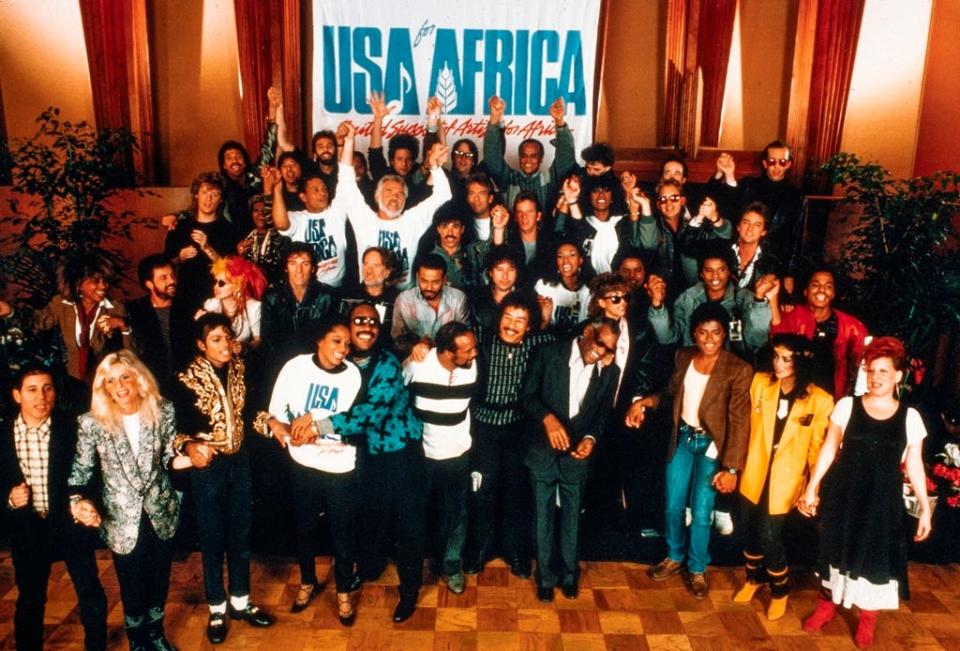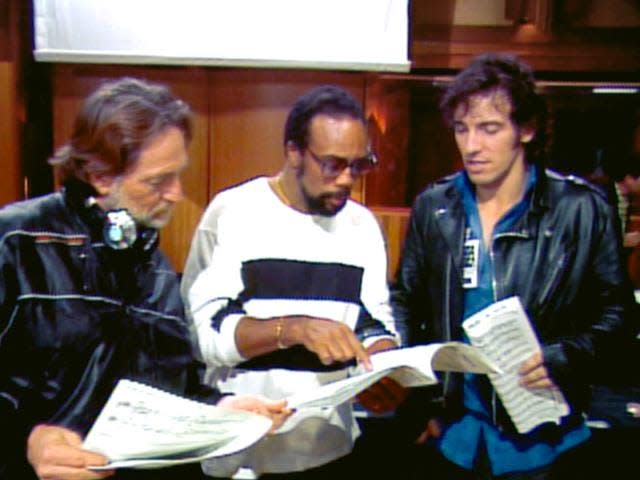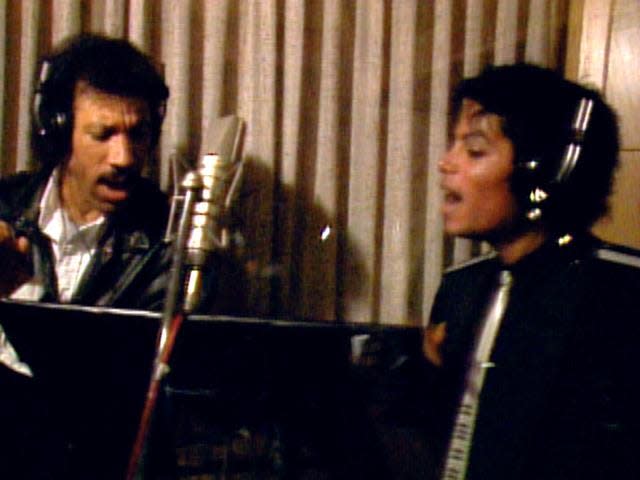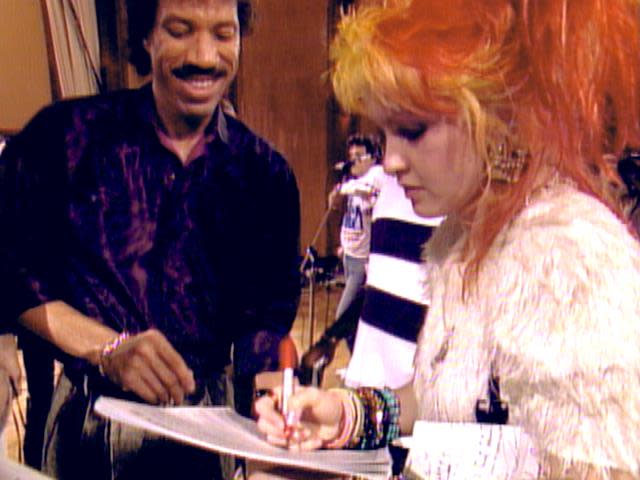Star power of 'We are the World' remains unmatched: Inside the dramatic 1-night recording
It’s impossible to explain to younger generations the implausibility of making "We Are the World" work.
Corralling 46 music stars – many of them the most consequential of their era – in one place, on one night, with one song to complete would be impressive today.
But to execute in a time when cellphones were rare and emails were esoteric, coordinating that many artists, agents, managers, songwriters and everyone else involved in fashioning one of the most indelible events in pop music history … well, it was a staggering feat.
That historical gathering on Jan. 28, 1985, is spotlighted in the documentary "The Greatest Night in Pop," which premiered at the Sundance Film Festival Friday and is streaming on Netflix now.
The 97-minute film weaves the origin of the song, written by Lionel Richie and Michael Jackson, with the tick-tock of how the night-into-morning unfolded as artists worked out their vocal parts, became "hangry" (chicken and waffles from Roscoe's was ordered) and sweetly emotional (Diana Ross asked Daryl Hall to autograph her sheet music). Original footage peeks into the creation of the recording with the all-star cast that included a baby-faced Bruce Springsteen, characteristically awkward Bob Dylan, spunky Cyndi Lauper, engaged Stevie Wonder and ponderous Paul Simon.
More: Where to watch 2024 Grammy Awards: TV channel, streaming info for 'Music's Biggest Night'

Lionel Richie, Michael Jackson and Quincy Jones spearhead 'We Are the World'
The genesis of "We are the World" stems from Ken Kragen, Lionel Richie’s manager.
Kragen wanted to use Band Aid, the collective of British musicians spearheaded by Bob Geldof that achieved worldwide attention for its charity single "Do They Know It's Christmas?" in 1984, as a blueprint for a song with American artists.
A call from Kragen to Richie "changed everything," the R&B-pop superstar recalled in an interview at Henson Recording Studios (formerly A&M Studios), where the assembly of musicians dubbed U.S.A. for Africa recorded "We Are the World." (New commentary also comes from other original participants, including Springsteen, Lauper, Huey Lewis, Dionne Warwick and Kenny Loggins.)

The snowball effect led to Richie enlisting good friend Quincy Jones to produce, Jones contacting Michael Jackson to help write the song with Richie, and Harry Belafonte sparking the idea to funnel proceeds from the single to benefit starvation in Africa.
The idea was sound. The implementation was challenging. And the result? Never to be duplicated.
Here are some revelations from the documentary spotlighting that one exceptional congregation with one rule from Jones, plastered on a handwritten sign above the doorway, Ted Lasso-style: "Check your egos at the door."
Many of the biggest stars almost didn’t make the 'We are the World' recording session
The recording date for "We are the World" purposely dovetailed with the American Music Awards earlier in the evening of Jan. 28 at the Shrine Auditorium in Los Angeles. Richie, as if he didn't have enough to focus on between tightening the song with Jackson and helping steer the stable of artists, also hosted and performed at the AMAs.
While the majority of singers attended the AMAs and could hop in their chauffeured cars for the 9-mile ride to A&M Studios in Hollywood after the ceremony, some schedules gave Richie heartburn.
As of 2 p.m. that day, Wonder was in Philadelphia.
Springsteen had wrapped the first leg of his Born in the U.S.A. Tour the night before in snowy Syracuse but vowed to hop on a flight west.
Jones called Warwick and told her she needed to be in Los Angeles, to which she replied, "No, I'll be in Las Vegas."
She wound up in Los Angeles.

Even those already on site, like Lauper, a two-time winner that night at the AMAs, injected drama into the run-up.
"Cyndi came to me during the (AMAs) and said, 'My boyfriend heard the song and he doesn't think it will be a hit, so I can't come,'" Richie said. "I said, 'Cyndi, it's pretty important for you to make the right decision.'"
Lauper, in a new interview, defended her stance at the time.
"Well, nobody knew (if it would be a hit)!," she said with a smile. "It was a great group of people, but I was so punch-drunk tired."
The pressure mounted on Richie, who succinctly summarized: "We had one night. They're not coming back tomorrow."
Sheila E. felt she was used to try to get Prince
The ace percussionist and longtime friend of Prince's performed "The Glamorous Life" on the AMAs and was invited by Richie to come to the studio after the show.
Prince was also at the show to collect three awards and uncork an incendiary rendition of "Purple Rain."
At the time, he and Jackson were perceived rivals, with each leapfrogging the other on the charts and magazine stands with "Thriller" and "Purple Rain." So, as Sheila E. said, the two of them singing on "We Are the World" would have made a potent statement.
At the studio, many musicians were murmuring about why Prince wasn't there.

Sheila E., led to believe she'd have a solo in the song, called Prince while she was waiting and told him. "Man, you should come. It's really cool." The enigmatic musician was at Mexican restaurant Carlos 'n Charlie's and told her he would stop by if he could play a guitar solo in another room, the antithesis of the spirit of the night.
"I knew he wasn't going to come because there were too many people," she remembered in a sit-down at Henson Studios.
After hours passed, Sheila E. realized, "They never intended to have me sing a verse, which was a little heartbreaking."
The lyric earmarked for Prince was given to Huey Lewis at the suggestion of Loggins.
Lewis, in a new interview, said that assignment made him so nervous that his legs started shaking.
Why wasn't Madonna part of 'We Are the World'?
While Kragen helped organize the throng of artists, Harriett Sternberg worked with him (among her duties was to express mail 45 cassettes of the demo Richie and Jackson recorded so artists could hear the song in advance) and recalled arguing with her boss about two of the biggest female stars at the time.
"I wanted Madonna, but Ken wanted Cyndi," she said matter-of-factly.

It's never explored why Madonna — a bonafide hitmaker by 1985 who presented at the AMAs — wasn't invited to participate, but in a recent interview, producer, musician and industry insider Nile Rodgers said that "some of her peers" felt she didn't deserve a spot in the lineup.
Lauper, meanwhile, a standout with her persimmon and banana-yellow hair, stunned the group into awed silence with her bulldozer of a voice. Amusingly, she needed a couple of takes because noise from her layers of jewelry kept tarnishing the recording.
Waylon Jennings left in the middle of recording
Early in the recording process, Wonder suggests the song should include Swahili, in honor of Africa. As he spitballs phrases and chants, with Al Jarreau leaning in to suggest or correct, Waylon Jennings loses patience with the process and the inclusion of the native language.
In the documentary, cameraman Ken Woo recalls Jennings' disgust.
"He said: 'Ain't no good ol' boy ever sung Swahili. I think I'm out of here,'" Woo said over footage of Jennings taking off his headphones and weaving his way through the cluster of artists and toward the door.
Richie also remembered the moment.
"(He said) 'I'm not dealing with this. I don't know what that means, but I'm not gonna say it,'" Richie says. "We lost Waylon right there."
More: Reba McEntire to sing national anthem at Super Bowl, plus Post Malone and Andra Day performances
This article originally appeared on USA TODAY: Netflix doc 'Greatest Night in Pop' explores 'We are the World' origin
